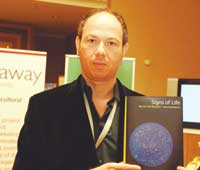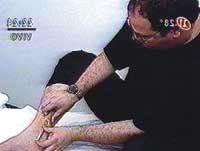
Khaleej Times (Weekend magazine), Dubai, UAE, 30 November 2007, pp. 22-24.
All in the name of art
By Pratibha Umashankar (Face To Face)
30 November 2007

He was the first person in the world to have a microchip implanted in his body as part of his work.
Professor Eduardo Kac, the well-known American contemporary artist combines robotics, networking and genetics to pose complex questions about the post-digital world and critique society. Here he fields questions about the strange wedlock between art and science.
HE SHOCKED television viewers in 1997 by injecting himself with a microchip on a live show in the context of his work, Time Capsule. In his work Teleporting an Unknown State, he enabled a plant in a dark room to grow with light sent from around the world through the Net by participants. For his work named Alba, he commissioned a French laboratory to create a green-fluorescent rabbit implanted with a GFP (Green Fluorescent Protein) gene from a type of jellyfish.
So where does science end and art begin? And how far can you stretch the definition of art? Are the lines between art and absurdity getting blurred? Can any zany idea be bandied around as art in the name of innovation? These are posers that spring to mind when you meet Professor Eduardo Kac, the erudite and enigmatic artist.
He exhibited Images of his work Move 36, in Abu Dhabi during the Festival of Thinkers in Abu Dhabi last month.
A professor of art, he believes in pushing the limit of his genre.
“I have no background in Science,” says Kac who is a full professor at the School of the Art Institute, Chicago. “My background is in Literature and Philosophy and I am an artist. I have a PhD in Interactive Art — it is the future of Art.”
Kac believes that an artist has an individual vision and brings something into the world which wasn’t there before. In that sense it is analogous to other fields of scientific enquiry.
He explains his complex work Move 36 — the images of which he brought to Abu Dhabi:
“Move 36 was the move made by the IBM computer Deep Blue in 1997 against the world chess champion Gary Kasparov. The match is significant because for the first time in history, a computer beat a human being at the game of chess. This has cultural and symbolic resonance as chess is emblematic of human intelligence. What was at stake was the symbolic limit of humankind. Symbolic, but at the same time very material. And this coming together of the material limits that we establish between humans, non-humans and machines is of great interest to me,” says Kac.
Kac’s bio-art is predicated on this joining of the material and the symbolic and represents the relationship between man and machine and the limits of the human mind.
“For Move 36 I created a new plant not created by nature. How did I do this? I took a sentence from the well-known philosopher Rene Descartes — “I think therefore I am”. I translated that sentence to the universal computer code and then translated that to genetics — the four letters of the alphabet that represents genetics — CGTA. The result was a sequence of the genetic basis that encoded the sentence from Descartes. I joined to this a gene that I created, another sequence — a mutant sequence — that comes from the tomato and allows the leaves of the plant to curve. And with that I created a plant that had curly leaves and allowed us to see where exactly the Descartian gene was located.
“This plant is located exactly on a chessboard made of earth and sand — earth representing life and sand being the material that constitutes the computer chip. And on this chessboard made of earth and sand, exactly where the computer made the winning move, I planted the new plant I created that joins the sentence — I think therefore I am — the universal code of computers and life, that is the plant itself.”
The question of life and art was always conjoined throughout the history of art, believes Kac. The vigour, vitality and the dynamism of life has always been at the very centre of any art discussion.
But why go to such great lengths to prove a point, one wonders.
“We live in a moment in history in which biotechnology is playing a fundamental role in redefining social relations, in creating new material, in revealing our proximity to other life forms, for example, the human genome project,” replies Kac. “All of this has tremendous cultural consequence.”
Talking about the term bio-art itself Kac explains: “I coined the term in 1997 when I created The Time Capsule, though I had introduced the concept of introducing life in art in 1984 in a work called Essay Concerning Human Understanding (See Box).
“In 1997, in the context of creating my work The Time Capsule, I myself implanted a microchip, becoming a sort of a cyborg. The cyborg is some sort of a hybrid of a human and a machine.
“I registered myself live on television in Sao Paulo, Brazil, on the Internet as a dog because the microchip was meant for the recovery and identification of animals (dogs) and the owner of the dog simultaneously. So I occupied both positions simultaneously. The microchip is now obligatory in the European Union for small domestic animals.
“But in 1997, it was not common. For a human to take that leap was seen in a very different light.
“I put the microchip in a syringe and with the syringe pierced the surface of the membrane of the skin and I injected myself.
I had in a sense, hybridised the television network, the Internet and the microchip database in my own body.”
What were the implications of this painful exercise?
“Several things,” he replies. “On the video in the background, I had seven sepia tone photographs. Such photographs take you back in time. They have unity and exist in the real world.
But our reality today is Network — it is a distributed reality. So why has art not moved into that new reality of today — out of finite space and time? That was the question I posed because I believe that art can move in a Network distributed flux from a fixed space.
“I was in Sao Paulo injecting a microchip into myself, and I had somebody in Chicago who clicked on a screen that activated the robotic fingers on Sao Paulo immediately, which then scanned me without physical contact. So there I was in Sao Paulo, somebody in Chicago, without touching me extracted digital information from my body that I carried through the microchip just as a machine carries digital information. With that number, I registered myself again live on the Internet in an American database for the recovery of lost animals. So Sao Paulo, Chicago, Paris, New York, Abu Dhabi … we are in a distributed world. So I am creating art that in itself is a network — a digital network.”
Where do the seven sepia-toned photographs come into all this?
“Photographs in the background had an important role to play. Photos are a way of externalising and fixing that memory for future generations. It is analogous memory, while the chip represents digital memory. I looked at the photo and internalised the memory. The microchip that was outside my body in seconds became internalised in me. The photos have a context, history, and emotions attached to it. But the microchip, despite its memory is a physical object. It has no context, history, or personal memory or identity.
So I wanted to confront the past of the analogue memory with the future of digital memory, having my body as the dividing line of the interface.

“With the photos, I internalised the memory that were external. With the microchip it was the opposite. I first internalised it physically and then, in a few seconds, somebody from far away extracted the digital information from my body and externalised it.
“What does this have to say about the future of digital memory? This was the question I wanted to ask because the microchip contained a sequence of numbers as if I were an animal. So I created a context where such questions could be asked.”
So, are we bracing ourselves for a future in which surveillance will be around us?
“Yes, admits Kac. For example, to come to Abu Dhabi I got my eyes scanned. Somebody went deep into my body, read information and put it in the database in 2007. In Norway, they took information from my fingertips. So today, our body is continuously being monitored and scanned and forming a database of information. Are we moving towards a society of absolute surveillance?”
So is the artist looking at an Orwellian Nightmare of a police state, with the Big Brother watching us through a microchip in our body?
“Yes, that’s true,” says Kac. “But more interestingly, we go around with earpieces of Bluetooth technology like prosthesis in our ears. We have other external devices that act as prosthesis. Also, we move data through computer networks and interact with others through computers. Physically this makes us appear to be more like computers than human beings.
“We sit in front of computers for long hours in right-angled postures and appear boxlike (with a cover with hinges) like a computer. We were not made to be like this and this will have long-term physically damaging effect on us, unless we bring back a sense of balance in our lives.
What I want to ask is, can interaction with other forms of network and data liberate us, by perhaps being coupled with us?
“What I want to know is, can I compute while I dance instead of being confined to a coffin-like form in front of a desk?
“The future opens itself with various possibilities — with an Orwellian type of nightmare and a dancehall type of a dream. Which one are we going to pursue?”
The artist leaves us with an open-ended question. Both alternatives seem a bit scary. What is, perhaps, even more scary is artists asking uncomfortable questions about the future that scientists are afraid or uncomfortable to ask.
Professor Kac gave a talk about his work and led a seminar on the relationship between humanity and science on October 23 at the INSEAD Abu Dhabi Centre, which is also one of the supporters of the artist’s visit to the UAE.
FOR HIS pioneering work in 1984 called Essay Concerning Human Understanding, Professor Eduardo Kac created an elaborate setting. The work involved a bird in one location and a plant in another country. The singing of the bird was relayed to the plant through the Internet. The plant was exposed to the sound through speakers. An electrode touching the leaf of the plant fed a group of elements that could produce a sound in real time in response to the singing of the bird. The sensation was felt by the plant and it reacted in a particular way. This reaction was relayed by an electrode and was translated into sound using a computer and relayed back to the bird. “This opened up a new channel in space and time,” says the artist.
Photos: Emmanuel Cornelius/Khaleej Times
Back to Kac Web